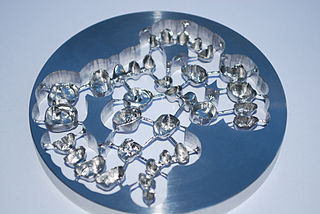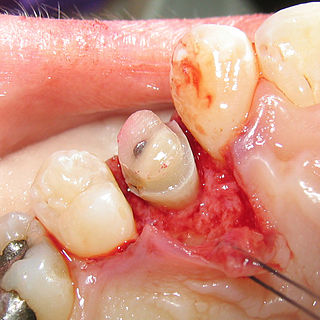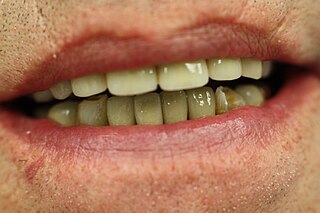Dental materials are specially fabricated materials, designed for use in dentistry. There are many different types of dental material, and their characteristics vary according to their intended purpose. Examples include temporary dressings, dental restorations, endodontic materials, impression materials, prosthetic materials (dentures), dental implants, and many others.

Endodontics is the dental specialty concerned with the study and treatment of the dental pulp.

A bridge is a fixed dental restoration used to replace one or more missing teeth by joining an artificial tooth definitively to adjacent teeth or dental implants.

Dental porcelain is a dental material used by dental technicians to create biocompatible lifelike dental restorations, such as crowns, bridges, and veneers. Evidence suggests they are an effective material as they are biocompatible, aesthetic, insoluble and have a hardness of 7 on the Mohs scale. For certain dental prostheses, such as three-unit molars porcelain fused to metal or in complete porcelain group, zirconia-based restorations are recommended.

In dentistry, a veneer is a layer of material placed over a tooth, veneers improve the aesthetics of a smile and/or protect the tooth's surface from damage.
Dens evaginatus is a rare odontogenic developmental anomaly that is found in teeth where the outer surface appears to form an extra bump or cusp.
Tooth gemination is a dental phenomenon that appears to be two teeth developed from one. There is one main crown with a cleft in it that, within the incisal third of the crown, looks like two teeth, though it is not two teeth. The number of the teeth in the arch will be normal.

A luting agent is an application of a dental cement. Luting agents connect an underlying tooth structure to a fixed prosthesis, hence giving rise to the term, luting agent, as they lute, or glue, two different structures together. There are two major purposes of luting agents in Dentistry – to secure a cast restoration in fixed prosthodontics, and to keep orthodontic bands and appliances in situ.

CAD/CAM dentistry is a field of dentistry and prosthodontics using CAD/CAM to improve the design and creation of dental restorations, especially dental prostheses, including crowns, crown lays, veneers, inlays and onlays, fixed dental prostheses bridges, dental implant supported restorations, dentures, and orthodontic appliances. CAD/CAM technology allows the delivery of a well-fitting, aesthetic, and a durable prostheses for the patient. CAD/CAM complements earlier technologies used for these purposes by any combination of increasing the speed of design and creation; increasing the convenience or simplicity of the design, creation, and insertion processes; and making possible restorations and appliances that otherwise would have been infeasible. Other goals include reducing unit cost and making affordable restorations and appliances that otherwise would have been prohibitively expensive. However, to date, chairside CAD/CAM often involves extra time on the part of the dentist, and the fee is often at least two times higher than for conventional restorative treatments using lab services. CAD/CAM is one of the highly competent dental lab technologies.
Fixed prosthodontics is the area of prosthodontics focused on permanently attached (fixed) dental prostheses. Such dental restorations, also referred to as indirect restorations, include crowns, bridges, inlays, onlays, and veneers. Prosthodontists are specialist dentists who have undertaken training recognized by academic institutions in this field. Fixed prosthodontics can be used to restore single or multiple teeth, spanning areas where teeth have been lost. In general, the main advantages of fixed prosthodontics when compared to direct restorations is the superior strength when used in large restorations, and the ability to create an aesthetic looking tooth. As with any dental restoration, principles used to determine the appropriate restoration involves consideration of the materials to be used, extent of tooth destruction, orientation and location of tooth, and condition of neighboring teeth.

Crown lengthening is a surgical procedure performed by a dentist, or more frequently a specialist periodontist. There are a number of reasons for considering crown lengthening in a treatment plan. Commonly, the procedure is used to expose a greater amount of tooth structure for the purpose of subsequently restoring the tooth prosthetically. However, other indications include accessing subgingival caries, accessing perforations and to treat aesthetic disproportions such as a gummy smile. There are a number of procedures used to achieve an increase in crown length.

Root canal treatment is a treatment sequence for the infected pulp of a tooth which results in the elimination of infection and the protection of the decontaminated tooth from future microbial invasion. Root canals, and their associated pulp chamber, are the physical hollows within a tooth that are naturally inhabited by nerve tissue, blood vessels and other cellular entities. Together, these items constitute the dental pulp. Endodontic therapy involves the removal of these structures, the subsequent shaping, cleaning, and decontamination of the hollows with small files and irrigating solutions, and the obturation (filling) of the decontaminated canals. Filling of the cleaned and decontaminated canals is done with an inert filling such as gutta-percha and typically a eugenol-based cement. Epoxy resin is employed to bind gutta-percha in some root canal procedures. Endodontics includes both primary and secondary endodontic treatments as well as periradicular surgery which is generally used for teeth that still have potential for salvage.
Restorative dentistry is the study, diagnosis and integrated management of diseases of the teeth and their supporting structures and the rehabilitation of the dentition to functional and aesthetic requirements of the individual. Restorative dentistry encompasses the dental specialties of endodontics, periodontics and prosthodontics and its foundation is based upon how these interact in cases requiring multifaceted care. In addition, restorative needs not derive from only diseases of the teeth like cavities and medical conditions but also from trauma. "Traumatic injuries to anterior (front) teeth are frequently encountered in children and adults". The degree of the trauma will dictate what restorative treatment will be needed and could involve one or more of the dental specialties listed above.
A resin-retained bridge is a bridge replacing a missing tooth that relies for its retention on a composite resin cement. It is one of many available dental restoration methods which is considered minimally invasive and conservative of tooth tissue. The resin-retained-bridge has gone through a number of iterations. Perhaps the best known is the Maryland bridge and other designs used in the past include the Rochette bridge. The five year survival rate is around 83.6% and ten year rate at 64.9%. The case selection is important and as with any dental prosthesis, good oral hygiene is paramount for success. In recent years, the indications for the use of resin-retained-bridges have diminished significantly and there have been changes in the principles underpinning their design. Resin-retained-bridges should be considered when a fixed prosthesis retained by natural teeth is required. The use has been driven by the advent of evidence-based dentistry showing the benefits to patients of reduced tooth preparation and the importance of an intact enamel structure for the long-term health of the teeth. The bridge is currently in favour in the United Kingdom for these reasons. Indeed, recent contemporary research shows resin retained bridges have better success rates than implants and are a cheaper alternative.
Dental cements are a group of materials with a wide range of dental and orthodontic applications. Common uses include temporary restoration of teeth, cavity linings to provide pulpal protection, sedation or insulation and cementing fixed prosthodontic appliances.
Endodontic crown is a single prostheses fabricated from reinforced ceramics, indicated for endodontically treated molar teeth that have significant loss of coronal structure. Endocrowns are formed from a monoblock containing the coronal portion invaded in the apical projection that fills the pulp chamber space, and possibly the root canal entrances; they have the advantage of removing lower amounts of sound tissue compared to other techniques, and with much lower chair time needed. They are luted to the tooth structure by an adhesive material. The ceramic can be milled using computer-aided techniques or molded under pressure. Endocrowns can be an alternative to conventional crown restorations.












